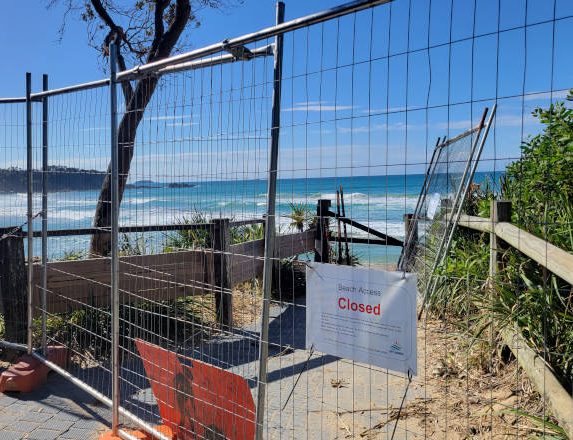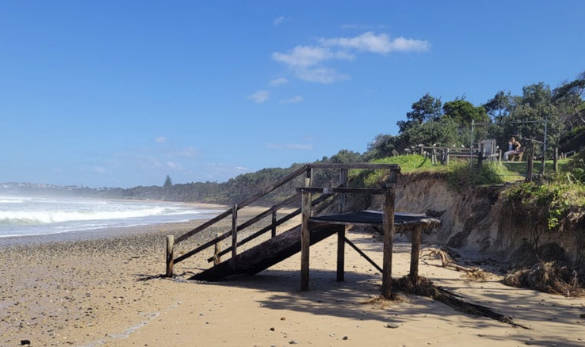It’s been a bruising few months for Australia’s coastline. A seemingly endless series of monster storms have whipped up giant waves that have smashed into rocks, beaches, sand dunes, and anything else in their path.
And slowly but surely, erosion is claiming ever larger chunks of land. Grey nomads who have been on the coast will have noticed stairs that once led down to golden sands now perched precariously over ‘cliffs’, or lookout structures that have collapsed after their pillars fell away, or even much-loved jetties appearing to be nearing the point of no return.
In recent weeks in SA alone, the iconic Port Germein jetty closed after it sustained serious damage, along with several others including those at Kingston, Robe, and Normanville.

Sign of the times! Many beach stairways are ciurrently closed.
And in the last week or so, a string of coastal properties on the NSW Central Coast were evacuated due to erosion fears.
Back in March, Cyclone Alfred dramatically changed the appearance of the Gold Coast’s famous beaches as tonnes of sand was swept away. And in WA, the scenic town of Lancelin is facing an evermore uncertain future, with metres of land disappearing in just months.
Back in 2023, a coastal risk management draft plan recommended the town remove assets and ‘retreat’ from forecasted flooding and erosion. This idea has since run into serious opposition. Of course, erosion also threatens the future of some beachside caravan parks.
In Kingscliff in northern NSW, sections of the caravan park were simply disappearing until the decision was made several years ago to build a multi-million-dollar sea wall to protect the park and the town.

Storm surges have wreaked havoc on beach stairways all around Australia. PIC: Cizza
But as the ocean continues its inexorable march, there are serious doubts whether sea walls, groynes and the like will be enough … and whether they are affordable.
Adam Gray, the executive officer for the SA Coastal Councils Alliance, said current planning was factoring in potential sea level rises of a metre by the end of this century.
“We are seeing intensifying storm events and there has to be investment in coastal management,” he said.
Mr Gray told the Grey Nomads the main options were: soft infrastructure, such as bringing in sand or planting mangroves; building hard infrastructure such as sea walls; adaptation, which might mean planning measures and things like elevated or relocatable buildings; and, finally, ‘retreat’.
“We are increasingly seeing infrastructure in danger; roads, esplanades, recreation zones, camping and coastal caravan parks … these are sites at risk,” said Mr Gray. “And it is not just on the coast, it affects our estuarine systems with sea level rises and high tides.”
He points at van parks in riverfront towns like Berri and Renmark, which have been hit hard by floods in recent years.
So, what can grey nomads do?
“Obviously council money comes from local ratepayers,” said Mr Gray. “But travellers can still drop into small communities, support local businesses … and just show good behaviour at camping spots.”
 WIN ONE OF THREE SKID ROW TRAILER SKIDS
WIN ONE OF THREE SKID ROW TRAILER SKIDS
Grey Nomad members are being given the opportunity to win one of three Skid Row Trailer Skids (each valued at $199). The ingenious Australian-designed device could come to the rescue of nomads who find their trailer or van stuck on sand, mud, or worse.
Manufactured from high-grade polypropylene, the ‘skid’ has been designed for use with or without the jockey wheel to accommodate different conditions in the retrieval process. The device is very compact (77cm x 39cm x 21cm), making it easy for grey nomads to store, and it weighs just 3.8 kilograms.
Click here to find out more.